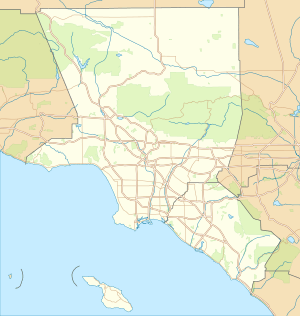Studio zone
| Studio zone Thirty-mile zone (TMZ) | |
|---|---|
|
The intersection at the center of the studio zone: West Beverly Blvd and North La Cienega Blvd in Los Angeles | |
 Studio zone Location of the center of the TMZ in Los Angeles | |
| Coordinates: 34°04′33″N 118°22′36″W / 34.075833°N 118.376667°W |
In the American entertainment industry, the studio zone, also known as the thirty-mile zone (TMZ) is the area marked roughly around a 30-mile (50 km) radius from the intersection of West Beverly Boulevard and North La Cienega Boulevard in Los Angeles, California, which at one time was the location of the headquarters of the Alliance of Motion Picture and Television Producers (AMPTP), the negotiating body for most studio management. This area includes almost all of the southern half of Los Angeles County, as well as slices of eastern Ventura County and northwestern Orange County.
Entertainment industry unions currently use this area to determine rates and work rules for union workers. The zone also largely determined the location and success of the original movie ranches in or near Hollywood. In addition, the studio zone includes some locations that technically lie outside the 30-mile radius. The Metro–Goldwyn–Mayer Conejo Ranch property near Thousand Oaks in Ventura County, and Castaic Lake in northwest Los Angeles County were included.[1]
In 2010, additional locations were added: Agua Dulce, the entire community of Castaic (in addition to Castaic Lake), Leo Carrillo State Park, Moorpark, Ontario International Airport, Piru, and Pomona (including the Fairplex of which a small portion is jurisdictionally in La Verne).[2][3] With respect to the locations added in 2010, producers are required to grant reasonable requests to actors for hotel accommodations if the locations listed above lie over four miles outside of the original thirty mile zone.[4] Other locations rejected in negotiations included adding Lancaster and Port Hueneme to the zone.[5] Addition of Pomona to the studio zone has led to an increase in filming.[6]
History and rationale
During almost all of the 20th century, the Hollywood entertainment industry preferred to film movies and television shows within the studio zone to hold costs down. With clever editing, it was easy to use a handful of aerial and location shots (usually shot by a second unit), along with carefully dressed sets, to give viewers the impression that a movie or show was set somewhere else. The studio zone itself, as well as the lack of motion picture production companies and experienced personnel outside the zone, made it very expensive to film on location, since movie studios had to bring everything needed from Los Angeles. In turn, anyone who wanted to start a career in the entertainment industry had to move to Los Angeles to break into the studio zone.
In the 1990s many countries and even other U.S. states began offering generous tax credits or deductions to offset the much higher cost of filming on location. The result was what Hollywood people call runaway production. Places such as New Orleans and Vancouver became popular—and cheaper—alternatives to filming in Los Angeles or New York City.[7]
Entertainment industry labor unions use this area to determine rates and work rules for workers. For instance, International Alliance of Theatrical Stage Employees contracts state:
Studio rates and working conditions shall prevail for all work performed within the studio zone; however, for newly called employees and those employees notified on the previous day prior to their departure from the studio (or the zone location) to report at the zone location, work time shall begin and end at the zone location; otherwise, work time shall begin and end at the studio. Such work time includes travel time both ways between the studio and the zone location.[8]
"Studio rates" are generally lower than "distant location rates", which would need to be paid (in addition to travel time and mileage) for work outside the studio zone.
The initials of the Time Warner tabloid news website TMZ.com stand for "Thirty Mile Zone", an alternative name for the studio zone.[9]
Quotes
- "In the film and TV locations business, contrary to the tenets of astrophysics, there actually is a center of the universe and it's at the corner of La Cienega and Beverly Boulevards. Where the Beverly Center meets the Beverly Connection is the dead center of Hollywood's so-called Studio Zone." —Christopher Grove, Variety [10]
- "… does the fact that a movie can be constructed outside the studio zone mean Hollywood insiders will no longer hold the keys to open the golden gate of the 'film industry'? Not quite." —Jeff Steele, TheWrap [11]
See also
References
- ↑ "Los Angeles Studio Zone Map". Entertainment Partners. Retrieved September 20, 2012. This site also states that the Long Beach Dome is "considered to be in the studio zone", but the designation is redundant for this specific location, as it lies within the 30-mile radius.
- ↑ IATSE/AMPTP Deal: 2% Wage Increases and First-Time Ever Health Premiums - The Hollywood Reporter
- ↑ Sagaftra.org
- ↑ Sagaftra.org
- ↑ Business Representative | IA.T.S.E. Local 80
- ↑ Land of Lincoln comes to Pomona via Hollywood
- ↑ Tuesday, Feb. 22: Filming Locations in Vancouver, Pittsburgh, Cincinnati, NYC, & more including ‘Ides of March’, ‘Supernatural’, ‘Blue Bloods’, & more
- ↑ "The 2003 – 06 Contract" (PDF). Archived from the original (PDF) on 2007-09-28. Retrieved 2007-06-10.
- ↑ "Slanguage". Variety.com.
- ↑ Grove, Christopher. "Small-screen scouts eye underexposed corners: Dressing the town for international looks." Variety, 2001-11-05.
- ↑ Steele, Jeff (20 February 2011). "Power to the People: the Democratization of Film". TheWrap. Retrieved 1 May 2014.
External links
Coordinates: 34°04′33″N 118°22′36″W / 34.07583°N 118.37667°W
